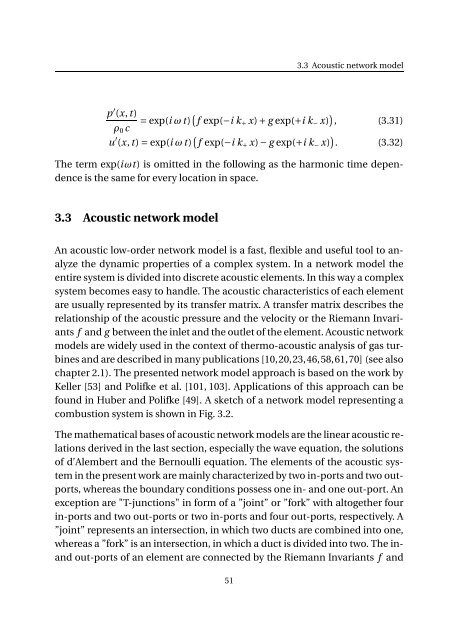Impact of fuel supply impedance and fuel staging on gas turbine ...
Impact of fuel supply impedance and fuel staging on gas turbine ...
Impact of fuel supply impedance and fuel staging on gas turbine ...
Create successful ePaper yourself
Turn your PDF publications into a flip-book with our unique Google optimized e-Paper software.
3.3 Acoustic network model<br />
p ′ (x, t )<br />
= exp(i ω t ) ( f exp(−i k + x)+ g exp(+i k − x) ) , (3.31)<br />
ρ 0 c<br />
u ′ (x, t )=exp(i ω t ) ( f exp(−i k + x)− g exp(+i k − x) ) . (3.32)<br />
The term exp(i ωt ) is omitted in the following as the harm<strong>on</strong>ic time dependence<br />
is the same for every locati<strong>on</strong> in space.<br />
3.3 Acoustic network model<br />
An acoustic low-order network model is a fast, flexible <str<strong>on</strong>g>and</str<strong>on</strong>g> useful tool to analyze<br />
the dynamic properties <str<strong>on</strong>g>of</str<strong>on</strong>g> a complex system. In a network model the<br />
entire system is divided into discrete acoustic elements. In this way a complex<br />
system becomes easy to h<str<strong>on</strong>g>and</str<strong>on</strong>g>le. The acoustic characteristics <str<strong>on</strong>g>of</str<strong>on</strong>g> each element<br />
are usually represented by its transfer matrix. A transfer matrix describes the<br />
relati<strong>on</strong>ship <str<strong>on</strong>g>of</str<strong>on</strong>g> the acoustic pressure <str<strong>on</strong>g>and</str<strong>on</strong>g> the velocity or the Riemann Invariants<br />
f <str<strong>on</strong>g>and</str<strong>on</strong>g> g between the inlet <str<strong>on</strong>g>and</str<strong>on</strong>g> the outlet <str<strong>on</strong>g>of</str<strong>on</strong>g> the element. Acoustic network<br />
models are widely used in the c<strong>on</strong>text <str<strong>on</strong>g>of</str<strong>on</strong>g> thermo-acoustic analysis <str<strong>on</strong>g>of</str<strong>on</strong>g> <strong>gas</strong> <strong>turbine</strong>s<br />
<str<strong>on</strong>g>and</str<strong>on</strong>g> are described in many publicati<strong>on</strong>s [10,20,23,46,58,61,70] (see also<br />
chapter 2.1). The presented network model approach is based <strong>on</strong> the work by<br />
Keller [53] <str<strong>on</strong>g>and</str<strong>on</strong>g> Polifke et al. [101, 103]. Applicati<strong>on</strong>s <str<strong>on</strong>g>of</str<strong>on</strong>g> this approach can be<br />
found in Huber <str<strong>on</strong>g>and</str<strong>on</strong>g> Polifke [49]. A sketch <str<strong>on</strong>g>of</str<strong>on</strong>g> a network model representing a<br />
combusti<strong>on</strong> system is shown in Fig. 3.2.<br />
The mathematical bases <str<strong>on</strong>g>of</str<strong>on</strong>g> acoustic network models are the linear acoustic relati<strong>on</strong>s<br />
derived in the last secti<strong>on</strong>, especially the wave equati<strong>on</strong>, the soluti<strong>on</strong>s<br />
<str<strong>on</strong>g>of</str<strong>on</strong>g> d’Alembert <str<strong>on</strong>g>and</str<strong>on</strong>g> the Bernoulli equati<strong>on</strong>. The elements <str<strong>on</strong>g>of</str<strong>on</strong>g> the acoustic system<br />
in the present work are mainly characterized by two in-ports <str<strong>on</strong>g>and</str<strong>on</strong>g> two outports,<br />
whereas the boundary c<strong>on</strong>diti<strong>on</strong>s possess <strong>on</strong>e in- <str<strong>on</strong>g>and</str<strong>on</strong>g> <strong>on</strong>e out-port. An<br />
excepti<strong>on</strong> are "T-juncti<strong>on</strong>s" in form <str<strong>on</strong>g>of</str<strong>on</strong>g> a ”joint” or ”fork” with altogether four<br />
in-ports <str<strong>on</strong>g>and</str<strong>on</strong>g> two out-ports or two in-ports <str<strong>on</strong>g>and</str<strong>on</strong>g> four out-ports, respectively. A<br />
”joint” represents an intersecti<strong>on</strong>, in which two ducts are combined into <strong>on</strong>e,<br />
whereas a ”fork” is an intersecti<strong>on</strong>, in which a duct is divided into two. The in<str<strong>on</strong>g>and</str<strong>on</strong>g><br />
out-ports <str<strong>on</strong>g>of</str<strong>on</strong>g> an element are c<strong>on</strong>nected by the Riemann Invariants f <str<strong>on</strong>g>and</str<strong>on</strong>g><br />
51
















